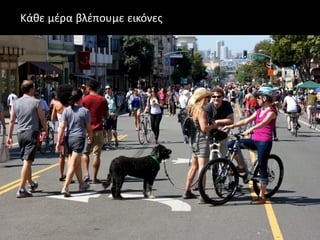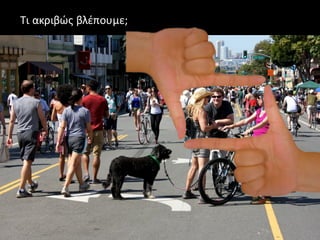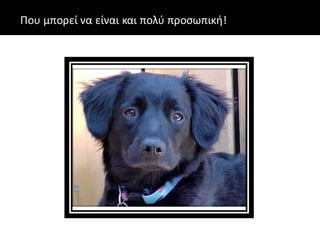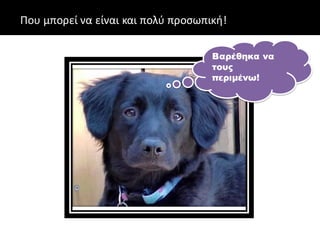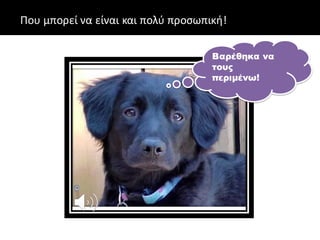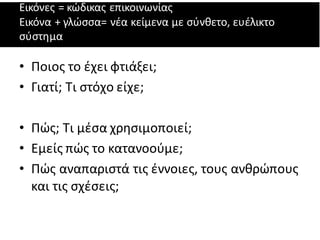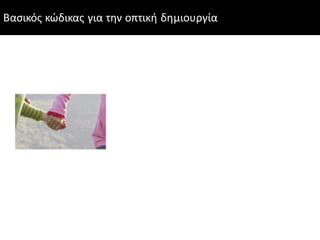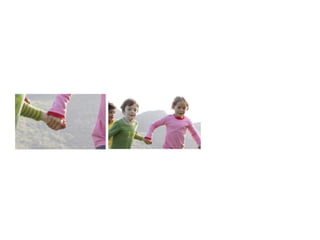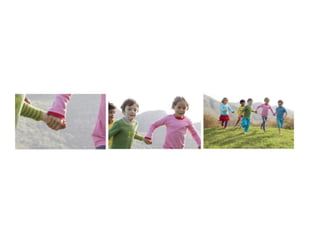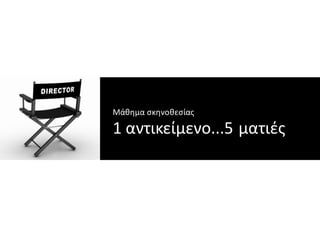О“О»ПүМҒПғПғОұ П„О·ПӮ ОөО№ОәОҝМҒОҪОұПӮ_ОңОӣОөПүОҪО№МҒОҙОұ_2023.pdf
- 1. О ПҺПӮ ОјО№О»О¬ОјОө ОјОө ОөО№ОәПҢОҪОөПӮ ОәОұО№ О®ПҮОҝП…ПӮ; ОңОұПҒОҜОұ ОӣОөПүОҪОҜОҙОұ www.karposontheweb.org
- 2. ОҡО¬ОёОө ОјОӯПҒОұ ОІО»ОӯПҖОҝП…ОјОө ОөО№ОәПҢОҪОөПӮ
- 4. Оҹ ОәОұОёОӯОҪОұПӮ ОјОұПӮ ОӯПҮОөО№ П„О· О”ОҷОҡО— П„ОҝП… ОҝПҖП„О№ОәО® ОіПүОҪОҜОұ
- 5. О ОҝП… ОјПҖОҝПҒОөОҜ ОҪОұ ОөОҜОҪОұО№ ОәОұО№ ПҖОҝО»ПҚ ПҖПҒОҝПғПүПҖО№ОәО®!
- 6. О ОҝП… ОјПҖОҝПҒОөОҜ ОҪОұ ОөОҜОҪОұО№ ОәОұО№ ПҖОҝО»ПҚ ПҖПҒОҝПғПүПҖО№ОәО®! О’ОұПҒОӯОёО·ОәОұ ОҪОұ П„ОҝП…ПӮ ПҖОөПҒО№ОјОӯОҪПү!
- 7. О ОҝП… ОјПҖОҝПҒОөОҜ ОҪОұ ОөОҜОҪОұО№ ОәОұО№ ПҖОҝО»ПҚ ПҖПҒОҝПғПүПҖО№ОәО®! О’ОұПҒОӯОёО·ОәОұ ОҪОұ П„ОҝП…ПӮ ПҖОөПҒО№ОјОӯОҪПү!
- 8. О•ОҫО№ ОөПҒПүП„О®ОјОұП„Оұ ОұПҖПҢ П„Оҝ British Film Institute (Bazalguette1989) вҖў Who is communicating, and why? Media Agencies вҖў What typeof text is it? Media Categories вҖў How is it produced? Media Technologies вҖў How do we know what it means? Media Languages вҖў Who receives it, and what sense do they make of it? Media Audiences вҖў How does it present its subject? Media Representations
- 9. О•О№ОәПҢОҪОөПӮ = ОәПҺОҙО№ОәОұПӮ ОөПҖО№ОәОҝО№ОҪПүОҪОҜОұПӮ О•О№ОәПҢОҪОұ + ОіО»ПҺПғПғОұ= ОҪОӯОұ ОәОөОҜОјОөОҪОұ ОјОө ПғПҚОҪОёОөП„Оҝ, ОөП…ОӯО»О№ОәП„Оҝ ПғПҚПғП„О·ОјОұ вҖў О ОҝО№ОҝПӮ П„Оҝ ОӯПҮОөО№ ПҶП„О№О¬ОҫОөО№; вҖў О“О№ОұП„ОҜ; ОӨО№ ПғП„ПҢПҮОҝ ОөОҜПҮОө; вҖў О ПҺПӮ; ОӨО№ ОјОӯПғОұ ПҮПҒО·ПғО№ОјОҝПҖОҝО№ОөОҜ; вҖў О•ОјОөОҜПӮ ПҖПҺПӮ П„Оҝ ОәОұП„ОұОҪОҝОҝПҚОјОө; вҖў О ПҺПӮ ОұОҪОұПҖОұПҒО№ПғП„О¬ П„О№ПӮ ОӯОҪОҪОҝО№ОөПӮ, П„ОҝП…ПӮ ОұОҪОёПҒПҺПҖОҝП…ПӮ ОәОұО№ П„О№ПӮ ПғПҮОӯПғОөО№ПӮ;
- 10. О ПҒПҢПғОІОұПғО·, ОұОҫО№ОҝО»ПҢОіО·ПғО·, ОҙО·ОјО№ОҝП…ПҒОіОҜОұ вҖў О’ОұПғО№ОәО® ОҙО№О¬ОәПҒО№ПғО· ОұОҪО¬ОјОөПғОұ ПғП„О·ОҪ ПҖОұПҒОұОіПүОіО® ОәОұО№ П„О·ОҪ ПҖПҒПҢПғО»О·ПҲО· вҖ“ О•ПҖО№ОәОҝО№ОҪПүОҪПҺ/ ОҙО·ОјО№ОҝП…ПҒОіПҺ ОјО·ОҪПҚОјОұП„Оұ ОјОӯПғОұ ПғОө ОҙО№ОұПҶОҝПҒОөП„О№ОәО¬ ПҖО»ОұОҜПғО№Оұ вҖ“ ОҡОұП„ОұОҪОҝПҺ ОәОұО№ ПғОәОӯПҶП„ОҝОјОұО№ ПҖО¬ОҪПү ПғП„Оҝ ПҖОөПҒО№ОөПҮПҢОјОөОҪОҝ П„ПүОҪ MОӯПғПүОҪ ОәОұО№ П„ПүОҪ ОҙО№ОұПҶОҝПҒОөП„О№ОәПҺОҪ ПҖО»ОөП…ПҒПҺОҪ П„ОҝП…ПӮ
- 11. О’ОұПғО№ОәПҢПӮ ОәПҺОҙО№ОәОұПӮ ОіО№Оұ П„О·ОҪ ОҝПҖП„О№ОәО® ОҙО·ОјО№ОҝП…ПҒОіОҜОұ
- 14. ОңО¬ОёО·ОјОұ ПғОәО·ОҪОҝОёОөПғОҜОұПӮ 1 ОұОҪП„О№ОәОөОҜОјОөОҪОҝ...5 ОјОұП„О№ОӯПӮ
- 17. О ОӯОҪП„Оө П„ПҒПҢПҖОҝО№: 1. ОҢПҖПүПӮ ОөОҜОҪОұО№ ПғП„О·ОҪ ОәОұОёО·ОјОөПҒО№ОҪПҢП„О·П„Оұ 2. ОҢПҖПүПӮ ПҖОҝП„Оӯ ОҙОөОҪ ОёОұ П„Оҝ ПғП…ОҪОұОҪП„ОҝПҚПғОұОјОө (ПғОҝП…ПҒОөОұО»О№ПғП„О№ОәО¬) 3. О©ПӮ ОұОҪП„О№ОәОөОҜОјОөОҪОҝ ОҙО№ОұПҶО®ОјО№ПғО·ПӮ (ОіО№Оұ ОҪОұ П„Оҝ ПҖОҝП…О»О®ПғОҝП…ОјОө) 4. О©ПӮ ОұПҶОҝПҒОјО® ОіО№Оұ ОҪОұ ОіОҪПүПҒО№ПғП„ОҝПҚОҪ ОҙПҚОҝ О® ПҖОөПҒО№ПғПғПҢП„ОөПҒОҝО№ О¬ОҪОёПҒПүПҖОҝО№ 5. О©ПӮ О®ПҒПүОұ ПҖОұПҒОұОјП…ОёО№ОҝПҚ ОЈОәОөПҶП„ОөОҜП„Оө: П„Оҝ ПҶПҢОҪП„Оҝ, П„О·ОҪ ОҝПҖП„О№ОәО® ОіПүОҪОҜОұ, П„Оҝ ПҒПҢО»Оҝ П„ПүОҪ ОұОҪОёПҒПҺПҖПүОҪ, П„Оҝ ПҮПҒПҺОјОұ ОәОұО№ П„Оҝ ПҶПүПӮ


